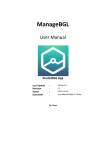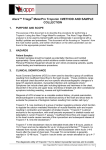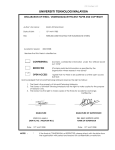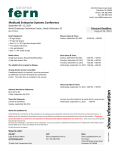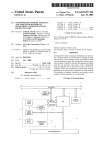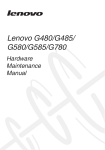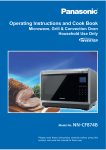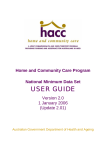Download Jan - Mar 2011
Transcript
MICA (P) 100/10/2009 Newsletter of Diabetic Society of Singapore Issue 36 January - March 2011 Smart Goals For 2011 How to keep New Year resolutions Snack Attack How to snack smart Gestational Diabetes How to manage it Diabetes During Pregnancy How to stay healthy MAKE A DIFFERENCE TO DIABETES NOW! An estimated 300,000 adults in Singapore have diabetes. Many have to deal with drastic changes to their lifestyles such as having to swallow handfuls of pills and getting up to four injections of insulin a day. Some unfortunately cannot cope and sadly go on to suffer from the ill effects of diabetes – heart attacks, amputations, blindness and kidney failure. The good news is ALL these ill effects of diabetes ARE PREVENTABLE! People with diabetes need our help and yours too! They need to learn to cope with diabetes. The Diabetic Society of Singapore has been given the privilege to lend a helping hand in educating people with diabetes, their loved ones and the general public on ‘HOW TO LIVE WITH DIABETES’. Helping people with diabetes is a privilege. Be that privileged person today. Diabetes may not be curable BUT its risks can certainly be reduced and so can the dreaded ill effects of heart attacks, amputations, blindness and kidney failure. DSS DONATION DRIVE I want to make a difference to diabetes today. Name : NRIC/Passport No.: Address : Postal Code : Contact No.: Office Home Hp/Pager Fax Email Please indicate amount and mode of payment: Amount paid: $ Cash/Cheque Cheque No.: Kindly address all cheques to: Diabetic Society of Singapore Blk 141 Bedok Reservoir Road #01-1529 Singapore 470141 *Cheque to be made payable to Diabetic Society of Singapore Donations are tax exempted. Cash donations can be made personally at our office at the above address. THANK YOU! CONTRIBUTORS WANTED! DO you have diabetes and want to share your story or are you a diabetes caregiver? A Medical Doctor? A Nurse Specialist? A Nutritionist? A Podiatrist? A Florist? An Artist…or just plain interested in Health and Health education? Get involved in Diabetes Care and Education! Contact us at Email: [email protected] 16 contents 12 20 22 News Buzz 6 Let’s Take Control of Diabetes. Now. World Diabetes Day 2010 8 Understanding Diabetes and In Control Self Care Management Workshop 2011 Care Corner 9 您检查了你的糖化血 红 蛋 白了(HbA1C) 吗? 10 Smart Goals For The New Year 12 Diabetes and Hypoglycaemia Healthy Makan 16 Tuna and Leek Tart 17 Silverfish with Peanut Brown Rice Porridge 18 Snack Attack In Shape 20 Drink up Special Feature 22 Managing Diabetes During Pregnancy 24 Gestational Diabetes Book Room 25 The Diabetes Manifesto: All the Resolution You Need Diablogue 26 All My Bags Are Packed… DSS MANAGEMENT COMMITTEE 2008/2010 PATRON: Prof Arthur Lim HONORARY SECRETARY: Ms Esther Ng ADVISOR: Dr Warren Lee ASST HONORARY SECRETARY: Ms Rohanah Bte Pagi PRESIDENT: Mr Yong Chiang Boon HONORARY TREASURER: Mr Stanley Lim VICE-PRESIDENTS: Dr Kevin Tan Eng Kiat Hj P.M. Mohd Moideen ASST HONORARY TREASURER: Ms Zann Lim COMMITTEE MEMBERS: Dr Yeo Kim Teck Mr For Wei Chek Mr GreIg Price 3 editor’s message diabetes singapore january - march 2010 Resolving a Resolute Resolution It is the time of the year, I suppose. A time for reflection. A time to take stock. A time to review what the year has been or hasn’t been. Call it your annual review or your personal “Watchnight Service”, if you will. We are talking about that “ironclad“ promise at the end or the beginning of the year. We resolve to forge a new beginning. We promise ourselves that we will do this and that. We are (were!) unwavering in our determination but these “irrevocable” resolves may last a few months or just weeks! Sounds all too familiar? You are not alone. I have personally lost track of the number of little and big resolutions made and broken. Truth be told, I am pretty sure that those of you reading this would have done the same, too. Very few of us have the will power and fortitude to stay the whole course and finish the race. What does this mean if you have diabetes? It is good to make resolutions about making renewed resolves to take care of your diabetes and yourselves. You aim to cut down on your salt intake until that next Teochew porridge with salted egg or salted fish dish, comes along. You promise your doctor (who is also probably indulging him or herself at some point, but hopefully not too frequently. I should know! ) or dietitian that you will watch your cholesterol until the aroma of fried kway teow or Hokkien mee weakens your every resolve. The fact is: looking after your diabetes in a veritable 24/7 food paradise is difficult, if not near impossible. It is akin to asking a kid in a toy store for the first time not too get too excited. The rest is always history. Do you give up because you just about break every promise you made to look after your diabetes better this year ? No! Consider the statistics. For every 1% reduction in your HBA1c towards the normal level you will reduce your correspondent risk of eye and kidney complications by 18%. Yes, 18 %. Not 1%. The similar risk reduction is 13% for every 10mm mercury pressure reduction in your high blood pressure towards the normal level. So make all those promises to yourself again. If you fail, you never fail alone! Wishing all our readers a Happy and Healthy New Year! 4 Dr Yeo Kim Teck Senior Consultant Apple Eye Centre Diabetes Singapore Editorial Team Editor : Dr Yeo Kim Teck Managing Editor : Charlotte Lim Editor (Medical) : Dr Elaine Huang Editor (Dietetics) : Janie Chua Editorial Consultants : DSS Management Committee Charlotte’s Web Communications Contributors : Praveen Gosal Kaur, Chionh Lay Keng, Janie Chua, Ong Fangyi, Ong Li Jiuen, Joslin Diabetes Centre, Rodiah Hashim, Amy Tenderich, Marco Aizawa Production/Advertising Manager : George Neo Advertising Coordinator : Esther Ng Publishing Services : Stamford Press Pte Ltd Booking for Advertisements : Tel: 6842 3382 Email: [email protected] Address feedback to: Managing Editor Diabetes Singapore Diabetic Society of Singapore Blk 141 Bedok Reservoir Road #01-1529 Singapore 470141 Fax: 68423118 Email: [email protected] For past issues of Diabetes Singapore, log onto: http://www.diabetes.org.sg/publication.html Disclaimer The views, opinions and recommendations given by the contributors of Diabetes Singapore or are merely for general reference. All materials in this newsletter are for informational purposes only. The individual reader should consult his own doctor or specialist for his personal treatment or other medical advice. Diabetic Society of Singapore and Diabetes Singapore Editorial Board disclaim all responsibilities and liabilities for content expressed in this newsletter including advertisements herein. All contents of the newsletter are the copyright of the contributors and newsletter. Reproduction in any form is strictly prohibited unless with written permission. Vice-president’s message diabetes singapore january - march 2010 A GOOD START New Year resolutions are commonly made at the start of a new year. Whether they are kept or not is another matter! If you are a person living with diabetes, what is your New Year resolution? I hope that among the many you make, you would include ‘improving my diabetes control’ (if you are not there yet) or ‘maintaining a good diabetes control’ (if you have achieved this over the last year) in your list. There is enough scientific evidence coming out from the last 10 years to confirm that the earlier you start and the longer you are able to maintain good diabetes control, the better chance you would have of preventing and delaying the onset of diabetes-related complications. Despite this knowledge, the statistics are dismal – about a third of persons achieve the target goals for blood sugar control, less than half achieve cholesterol targets and less than a third achieve blood pressure goals from recent data coming out from the USA. The reasons vary. Sometimes doctors don’t push for these targets or communicate them to patients. Other times, patients resist doctors’ efforts to increase the medication dose in order to achieve these goals. So, it is timely to be reminded and to set the course for the New Year. Of course, this may not come easy. You would need to be more careful over what you eat, watch more carefully your carbohydrate consumption, firm up the exercise schedule that has been planned but never instituted, shed some of that extra weight and cooperate with your doctor on the types and amount of medicine you need to take! It may even mean that you finally agree to start insulin after months of refusing to do so. While it appears that you may be losing your freedom with all these restrictions and routines, you are in reality gaining a lot more than just diabetes control. With this food-for-thought, may you hop into the New Year with resolute determination to improve your diabetes care! Wishing all a diabetes-healthy 2011! Dr Kevin Tan Vice-President, Diabetic Society of Singapore Consultant in Diabetes, Endocrinology and Internal Medicine 5 news buzz diabetes singapore january - march 2010 Let’s Take Control of Diabetes. Now. World Diabetes Day 2010 By Rodiah Hashim the event with students and members of the Scouts Association leading the flock from and back to the nearby Yio Chu Kang Stadium. In response to the worldwide call to countries united in the fight against Diabetes to light up iconic landmarks and buildings in blue to mark World Diabetes Day, The Singapore Flyer became the first Singapore landmark to sparkle to commemorate this year’s World Diabetes Day on 14 November. And in line with Diabetic Society of Singapore’s mission to reach out to the community, World Diabetes Day 2010 was held in the heartland at the Grassroots’ Club, Ang Mo Kio Avenue 8. A 2-kilometre ‘Walk for Diabetes’ kicked off 6 Celebrated in conjunction with Singapore National Eye Centre’s (SNEC) 11th National Eye Care Day, WDD has a pressing message for the local community and the world at large: “Let’s Take Control of Diabetes. Now.” Guest-of-Honour Mr Masagos Zulkifli Bin Masagos Mohamad, Minister of State, Ministry of Education and Ministry of Home Affairs, mentioned in his opening speech that all around the world, the standard of news buzz healthcare has improved, leading to more people living longer lives. Unfortunately, the fast-growing fast-food culture and prevalence of sedentary jobs are causing us to make unhealthy and dire lifestyle choices. People are not only exercising less but also eating less healthy food in larger quantities, resulting in a distressing increase in the total number of people in the world with diabetes. A whopping 7 million people are estimated to be suffering from the dreaded disease. It is not surprising then that the critical messages for WDD 2010 and beyond focus on early diagnosis of diabetes, prevention of diabetes and proper control of diabetes to prevent complications. The urgency of getting the message across has prompted the launch of the ‘Diabetes Awareness Badge’, a collaboration between Diabetic Society of Singapore, The Scouts’ Association and Girl Guides Singapore to raise awareness of the dangers associated with the disease and to educate the masses on managing the condition. Activities that day created quite a buzz with health screenings - blood sugar checks, blood pressure checks, obesity checks, tests for diabetes control plus eye checks by SNEC doctors and nurses and feet checks by the Podiatry Association of Singapore. Dietitians from the Temasek Polytechnic provided counselling on dietary matters and cholesterol control, while Diabetes Nurse Educators from the Association of Diabetes Educators, Singapore, used visually engaging conversational maps to educate on diabetic care and management. Doctors and nurses talked about Heart Health and Insulin use in one segment and the DSS booth was bustling with enquiries and a health quiz. Participants walked away with goodies, discounts and great deals offered by the exhibitors from pharmaceutical companies dealing with diabetes-related products. diabetes singapore january - march 2010 Diabetic Society of Singapore would like to thank the following for their sponsorship and support: MAIN SPONSORS 1 2 Cityneon Exhibition Services (S) Pte Ltd The Grassroots’ Club SPONSORS 1 2 3 4 5 6 7 8 9 10 11 12 13 14 15 16 17 18 19 20 21 22 23 24 25 26 27 28 29 30 31 32 Abbott Diabetes Care Abbott Laboratories (S) Pte Ltd (Nutrition) Asia Medical Supplies Pte Ltd AstraZeneca Singapore Pte Ltd Bayer (SEA) Pte Ltd BD Medical Surgical Systems Boehringer Ingelheim Singapore Pte Ltd Digisound Hearing Care Centre Eli Lilly (Singapore) Pte Ltd Gardenia Foods (S) Pte Ltd Haw Par Corporation Ltd Imexlink Trade Pte Ltd Lifescan - Johnson & Johnson Medical Singapore LION Corporation Pte Ltd L-Tac MediCare Pte Ltd Medimex Singapore Pte Ltd Merck Pte Ltd Nestle (Singapore) Pte Ltd Novartis (Singapore) Pte Ltd Novo Nordisk Pharma (Singapore) Pte Ltd NTUC Healthcare Co-operative Ltd Pfizer Pte Ltd Public Utilities Board Roche Diagnostics Asia Pacific Pte Ltd sanofi-aventis Singapore Pte Ltd Servier Singapore Pte Ltd Spectacle Hut Pte Ltd Tat Hui Foods Pte Ltd Terumo Corporation Singapore The Sukha House Pte Ltd Toyogo (Singapore) Pte Ltd Unifood International (S) Pte Ltd SUPPORTING ORGANIZATIONS 1 2 3 4 5 6 7 8 9 10 11 12 13 14 Association of Diabetes Educators (Singapore) Girl Guides Singapore Health Promotion Board Leo Club of Ahmad Ibrahim Secondary School Leo Club of Singapore Metropolitan Leo Club of Singapore Polytechnic Lions Club of Singapore Metropolitan Podiatry Association (Singapore) Singapore Flyer Singapore Heart Foundation Singapore Nutrition & Dietetics Association Singapore Physiotherapy Association Singapore Scouts Association Temasek Polytechnic 7 news buzz diabetes singapore january - march 2010 Understanding Diabetes and In Control Self-Care Management Workshop 2011 e Self-Care Management Understanding Diabetes and In Control is a 4-week comprehensiv Workshop. Topics covered in the class include: Guidelines on diabetes self-care Glucose testing and recording Understanding medications Foot care Nutrition Exercise Complications of diabetes Cost Fee: $21 per person (4 sessions) These classes are offered at: 8 Tel: 6564-9818 South West DECC Blk 528 Jurong West Street 52, #01-353 S64052 Tel: 6842-3382 DSS @ Bedok Blk 141 Bedok Reservoir Road #01-1529 S470141 2 Tel: 6398-0282 Central Singapore DECC Blk 22 Boon Keng Road #01-15 S33002 Understanding Diabetes and In Control Schedule 2011 CENTRAL SINGAPORE DECC ENGLISH CHINESE DSS @ BEDOK ENGLISH Malay May 5,12,19,26 Thursday 6-8pm Jul 5,12,19,26 Tuesday 6-8pm ENGLISH CHINESE Feb 1,8,15,22 Tuesday 6-8pm Apr 7,14,21,28 Thursday 6-8pm Mar 8,15,22,29 Tuesday 6-8pm SOUTH WEST DECC Apr 5,12,19,26 Tuesday 3-5 pm Aug 4,11,18,25 Tuesday 6-8pm Jun 2,9,16,23 Thursday 6-8pm Oct 4,11,18,25 Tuesday 6-8pm Sep 6,13,20,27 Tuesday 6-8pm call the respective centres to register. Kindly note that the above dates are subject to change. Please Supported by Lions Diabetes Program Revised on 27 Dec 2010 8 care corner diabetes singapore january - march 2010 您检查了你的糖化血 红 蛋 白了(HbA1C) 吗? by Chionh Lay Keng 糖尿病如果不把血糖控制好就会引起併发症如: 肾脏病, 失明,中凤,心脏病,截肢与手脚麻痹等等。 什么是糖化血红蛋白? 这是90-天( 3 个月) 内的平均血糖值,正常范围在4.6 6.4%之间。一般为糖尿病患者设定的血糖控制目标是 HbA1C在7% 以下. 每个糖尿病患者都应该在每三个月检查他们的糖化血红蛋 白.因为一旦超标, 就得检讨饮食̖̖ 药物和运动之间是否取得 平衡而加以调整. 所有糖尿病患者都得学习如何运用饮食̖̖药物̖运动与自我测 量血糖来更好的控制自己的血糖。 您如果还没做HbA1C的检验或还没学习糖尿病自我管理 课程,请播电到以下新加坡糖尿病协会预约。 别等了,今天就下定决心学习如何控制你的糖尿病吧! DSS HQ @ Bedok Blk 141 Bedok Reservoir Road #01-1529 Singapore 470141 Tel: (65) 6842 3382 Hong Kah Diabetes Education & Care Centre Blk 528 Jurong West St 52 #01-353 Singapore 640528 Tel: (65) 6564 9818 Central Singapore Diabetes Education & Care Centre Blk 22 Boon Keng Road #01-15 Singapore 330022 Tel: (65) 6398 0282 9 care corner diabetes singapore january - march 2010 SMART Goals For The New Year Taking care of yourself when you have diabetes is more than taking medications and going for medical appointments. It usually involves making lifestyle changes which can be overwhelming and often require a considerable amount of effort. Henry Lew, psychologist, shows you how to set goals you can reach as you usher in the new year. “After a while I just found it hard to track what food to eat, what not to eat, and when it rains or I feel slightly tired I just end up doing other housework and I forgot to go for my morning walks,” said Madam Jannifa. “What’s there to plan?” asked Mr Foo. “I just need to take my medication and follow what the doctor, nurses and dietitian tell me what to eat and what not to eat.” Or so he thinks. Sounds familiar? If you’ve been in Madam Jannifa’s shoes, you know you will soon be sliding down the slippery slope to complacence and your diabetes will be spinning out of control. “It’s actually very simple to exercise. It’s all in my mind,” said Madam Zaafira. Like many diabetes patients, you begin with the honourable intention to make lifestyle changes but when you face a chain of challenges, you lose your motivation along the way. Eventually, you just stop trying and give up. The main reason for many disappointing outcomes is often due to a lack of planning and goal setting. 10 Like Mr Foo and Mdm Zaafira, you might have also felt that it is unnecessary to plan and you can do it on your own. Taking responsibility and ownership of the lifestyle changes is the very foundation of selfmanagement in diabetes. However, as the famous proverb goes, “he who fails to plans, plans to fail.” Honestly, how many times have you said, “I am going to exercise” but ended up doing something else like watching TV or reading a book? How many times have care corner you tried to eat healthy for a few days but ended up returning to your old diet of greasy foods? Properly set goals help us to specify “what”, “how” and “when” we want to make behavioural health changes regarding exercise and diet. In specifying our goals, we have a list of “steps” to follow through. It is similar to having the ease of a user’s manual when we first purchase an electronic equipment instead of trying to figure out what to do on our own. Goals are also like signposts along the road. They provide us with a direction so that we can concentrate our efforts in the right area and achieve the lifestyle changes we want to make. In addition, properly set goals also help us to monitor if we are on track. Goal Setting Tips Below are some tips to help you set goals in a productive manner so that you would be more likely to carry it through. If you are in the process of making New Year Resolutions for 2011, perhaps improving your health is on your list. Why not try the following out to help yourself make further behavioural changes for your diabetes? 1. First, ask yourself “What do you want to accomplish?” 2. How Important is it for you to accomplish this? On a scale of 1 to 10, with 1 being not important for you to accomplish this aim, and 10 being very important for you to accomplish this, what number would you give as the importance level to accomplish this task? 3. How Confident are you to accomplish this? On a scale of 1 to 10, with 1 being not confident at all to accomplish this aim, and 10 being very confident to accomplish this, what number would you give as your confidence level to accomplish this task? 4. If your ratings to both questions 2 and 3 are higher than 5, you may proceed to the question 7 as this means that your goal setting and behavioural changes are less likely to be affected by your level of confidence and motivation. 5. If your rating is lower than 5 for question 2 (that is, your importance level is rated below 5), get the facts from a healthcare professional who can explain them clearly to you. Initially, Mr Foo did as he was told but he did not really understand the reasons and was not fully convinced why he needed to make those changes. After a nurse explained that diabetes is not just about taking medication, he diabetes singapore january - march 2010 became more motivated to make dietary changes and even participated in physical activities. 6. If your rating is lower than 5 for question 3 (that is, the confidence level is rated below 5), getting professional help might be a good start. Madam Jannifa wanted to watch her diet but she had little confidence about succeeding. After speaking to a dietitian, she picked up tips on how to make changes to her diet rather than rely on what she had heard from friends and relatives. This helped to boost her confidence and make her change in her diet easier to achieve. 7. Are your goals SPECIFIC? Do they detail the ‘where’, ‘when’, ‘what’, ‘how’ and ‘with whom’, where relevant. For example, “I will watch my diet” is a vague goal. “I will eat only half a bowl of rice during lunch on weekdays” is considered a specific goal that sets the time, day and action to be taken. This provides specific steps to guide our behaviour. 8. Are your goals MEASURABLE? In other words, can your goals be measured in numbers? “I want to lose weight” is not a measurable goal. How would you know if you have lost weight? “I want to lose 3kg within 4 months”. This is a measurable goal; it tells us how much weight we want to lose and by when. Measurable goals provide a reference to see if we are on track. 9. Are your goals ACHIEVABLE and REALISTIC? Are you being overly ambitious in your goals that you might just push yourself too fast and far? Do your circumstances allow you to carry out your goals in a practical way or are you setting yourself up for disappointment? “I want to exercise every day for 45 minutes starting tomorrow” is a specific and measurable goal, no doubt. But to someone who has not exercised at all or who has stopped exercising for a long time, it will be unrealistic to expect him to do so. Perhaps it might be more realistic for such an individual to first consult his doctor and start off at a slower pace and then build up from there. 10. Are your goals TIMELY? This means that if there is a timeframe involved, you need to decide how often you are going to do it, how long for each time, and length of period from when to when. SPECIFIC, MEASURABLE, ACHIEVABLE, REALISTIC, TIMELY goals. Notice the first letters of each word form the acronym SMART. Start the year ahead with SMART goals and take the great leap forward in improving your behavioural health! 11 care corner diabetes singapore january - march 2010 Diabetes and Hypoglycaemia By Praveen Gosal Kaur, diabetes nurse educator, Diabetic Society of Singapore 12 care corner diabetes singapore january - march 2010 What is Hypoglycaemia? Hypoglycaemia defined as low blood sugar occurs when blood glucose levels fall below 4 mmol/l or 70mg/dL. It can happen suddenly and can be treated quickly and easily by eating or drinking a small amount of glucose-rich food. If left untreated, however, hypoglycaemia can get worse and cause confusion, clumsiness, or fainting. Severe hypoglycaemia can lead to seizures, coma, and even death. What are the symptoms of Hypoglycaemia? Hypoglycaemia causes symptoms such as • • • • • • • • • • Hunger Trembling hands Nervousness Sweating Dizziness or light-headedness Tiredness Confusion Moody Difficulty in speaking Unconsciousness What causes of Hypoglycaemia? Hypoglycemia is caused by a variety of different factors such as the following: • • • • • Hypoglycemia can occur as a side effect of an oral diabetes medications, including insulin. In people on insulin or oral diabetes medications, low blood glucose can occur if meals or snacks are too small, delayed or skipped. Increased physical activity can cause hypoglycaemia when the body requires more energy than the calories you have eaten can provide. Drinking alcoholic beverages, especially binge drinking, can cause hypoglycaemia. The body’s breakdown of alcohol interferes with the liver’s efforts to raise blood glucose. Hypoglycaemia caused by excessive drinking can be serious and even fatal. How is Hypoglycaemia treated? Signs and symptoms of hypoglycaemia vary from person to person. People with diabetes should be aware of their signs and symptoms and inform their friends and family so they can help, if needed. People with regular episodes of hypoglycaemia should contact their health care provider. Modifications of their treatment plan may be required: less medication or a different medication, a new schedule for insulin or medication, a different meal plan, or a new physical activity plan. Immediate Treatment for Hypoglycaemia When a person feels that his blood glucose level is low, he should check it immediately with a glucometer. If the level is below 4 mmol/l, one of these quick-fix foods should be consumed right away to raise blood glucose: • • • • 3 tsp of sugar 1/2 cup of any fruit juice 1/2 cup of a regular—not diet—soft drink 3 pieces sweets Recommended amounts may be less for small children. The child’s doctor can advise on the appropriate amount. The next step is to recheck blood glucose in 15 minutes to make sure it is 4 mmol/l or above. If it is still too low, another serving of a quick-fix food should be eaten. These steps should be repeated until the blood glucose level is 4 mmol/l or above. If the next meal is an hour or more away, a snack should be eaten once the quick-fix foods have raised the blood glucose level to 4 mmol/l or above. It is important to note that treatment for hypoglycaemic should be carried out only to a maximum of 3 times. If blood sugar levels fail to increase after the third treatment, it is advisable to seek medical help at the nearest hospital. 13 care corner How can Hypoglycaemia be prevented? To prevent hypoglycaemia, people with diabetes should always consider the following: • Diabetes Medications - Diabetes treatment plans are designed to match the dose and timing of medication to a person’s usual schedule of meals and activities. Mismatches could result in hypoglycaemia. For good diabetes management, people with diabetes should take diabetes medications in the recommended doses at the recommended times. It is important to discuss with their doctor or diabetes nurse educator regarding these following points: o o o o o o • 14 whether their diabetes medications could cause hypoglycaemia when they should take their diabetes medications how much medication they should take whether they should keep taking their diabetes medications when they are sick whether they should adjust their medications before physical activity whether they should adjust their medications if they skip a meal Having regular meals - People with diabetes should eat regular meals, have enough food at each meal, and try not to skip meals or snacks. Snacks are particularly important for some people before going to sleep or exercising. diabetes singapore january - march 2010 • Their daily activity - To help prevent hypoglycaemia caused by exercise, health care providers may advise checking the following: o o o blood sugar levels before sports, exercise, or other physical activity and having a snack if the level is below 100 mg/dL or 5.5 mmol/l blood glucose at regular intervals during extended periods of physical activity and having snacks as needed blood glucose periodically after physical activity. • Alcoholic beverages - Drinking alcoholic beverages, especially on an empty stomach, can cause hypoglycaemia. Excessive drinking can be harmful for people taking insulin or medications that increase insulin production. Alcoholic beverages should always be consumed with a snack or meal at the same time. Discuss with the health care provider who can suggest how to safely include alcohol in a meal plan. • Driving - To prevent hypoglycaemia while driving, people at risk should check their blood glucose level before driving. Blood sugar levels should be monitored frequently during long trips. Eat snacks as needed to keep the blood sugar level above 70 mg/dL or 4 mmol/l. If necessary, stop for treatment and then make sure the blood glucose level is 4 mmol/l or above before starting to drive again. care corner • Being prepared for hypoglycaemia - Always be prepared to prevent and treat low blood glucose by: o o o o o learning what can trigger low blood glucose levels; having a blood glucose meter available to test glucose levels; frequent testing may be critical for those with hypoglycaemia unawareness, particularly before driving a car or engaging in any hazardous activity; always having several servings of quickfix foods or drinks handy; planning what to do if you develop severe hypoglycaemia; telling your family, friends, and coworkers about the symptoms of hypoglycaemia and how they can help, if needed. diabetes singapore january - march 2010 Nocturnal Hypoglycaemia Hypoglycaemia can also happen during sleep. This is known as nocturnal hypoglycaemia. Although nocturnal hypoglycaemia is most common in insulin users, it can also occur for people who take oral anti-diabetic drugs. Sometimes they may wake up during an episode of nocturnal hypoglycaemia but if they don’t, then it is important to take note of one or more of these following indications that a hypoglycaemic episode may have occurred while asleep:• • • • • Crying out or having nightmares Waking with a headache Finding pyjamas or sheets damp from perspiration Feeling unusually tired after waking up Having a clammy neck can be a particular indication of night time hypoglycaemia Causes of Nocturnal Hypoglycaemia Chances of having night time hypos may be increased by the following: • • • • • Physical activity during the day can increase insulin sensitivity which can lead to night time hypoglycemia, particularly for the first night after a sustained session of activity Absence of a night time snack when one is usually taken Alcohol consumption Too high a level of bedtime insulin Following a period of illness Preventing Night Time Hypoglycaemia If a person with diabetes experiences frequent nocturnal hypos, he should consult the doctor or diabetes nurse educator to discuss the appropriate changes to be made to their treatment plan, specifically regarding meals and daily activities. References http://www.diabetes.co.uk/Diabetes-and-Hyperglycaemia.html http://diabetes.niddk.nih.gov/dm/pubs/hypoglycemia/ 15 healthy makan diabetes singapore january - march 2010 TUNA AND LEEK TART Makes 12-14 tarts by Ong Fangyi, dietitian, National University Hospital Ingredients Method Filling* ½ cup chopped capsicum ½ cup chopped broccoli ½ cup chopped cherry tomatoes 1 carrot, chopped 150g leek, sliced thinly 1 can tuna in spring water, drained 2 cloves garlic 3 eggs, beaten ½ cup low fat milk 15ml soy sauce, light 5 ml soy sauce, dark 10ml light soy sauce into batter 15ml olive oil Pepper ½ cup grated low fat cheese 1. Preheat oven to 220ºC. * you may vary the vegetables Crust Springroll pastry (1 packet of 40 small squares) 2. Line greased muffin tray with 2 spring roll skins crisscrossed per hole, folding in the edges. 3. Heat 15ml of oil, add in the leek, garlic and fry till lightly brown. Then, add carrots, capsicum, broccoli, soy sauce and a dash of pepper. Add tomatoes and stir fry for just 1 to 2 minutes. 4. Line the pastry with a layer of tuna, then the stir fry the vegetables. 5. Prepare the batter by adding ½ cup of milk and 10ml soy sauce to the 3 beaten eggs. 6. Fill the pastry with batter, give the filling a slight stir to ensure there are no air pockets and that the batter sits at the bottom. Top with some cheese. 7. Bake the tarts for about 15 to 20minutes till light golden brown and the batter sets. Nutrient Analysis (1 tart will give:) Equipment Muffin tray Frying pan Wooden spoon Oven Measuring cups 16 Energy 93 kcal Protein 6.8 g Fat 3.6 g Saturated Fat 0.7 g Cholesterol 49 mg Carbohydrate 8g *Carbohydrate exchange 0.5 exchange Sodium 205 mg healthy makan diabetes singapore january - march 2010 Silverfish with Peanut Brown Rice Porridge Serves 4 by Janie Chua, dietitian, National Healthcare Group Polyclinics Ingredients Method 1 cup brown rice, rinsed 2 litres water 100g silverfish, rinsed 250g skinless chicken breast, sliced 100g raw peanut, soaked in hot water, drained 8 red dates, rinsed 1 tbsp wolfberry, rinsed 1 tsp salt 1. Put brown rice, peanut, chicken meat, silverfish, red dates, wolfberry into a pot with water and bring to boil. 2. Once boiled, simmer and set at low heat for 2 to 3 hours. 3. Once cooked, season with salt. 4. Serve hot. Nutrient Analysis (Per Serving) Energy 410 Kcal Protein 28 g Fat 16 g Saturated Fat 3.0 g Cholesterol 122 mg Carbohydrate 38 g *Carbohydrate exchanges ~ 2.5 exchange Dietary Fibre 3.7g Sodium 530 mg 17 healthy makan diabetes singapore january - march 2010 SNACK ATTACK Who says you can’t snack when you have diabetes? Ong Li Jiuen, dietitian, Changi General Hospital, shows you how to snack smart. Did you know that a handful of almond nuts (about 15 nuts) contains almost 100 calories. If you eat a cup of almond nuts, you would have eaten almost 800 calories! That’s almost equivalent to eating a burger with fries! But smart snacking can help keep blood sugar and energy levels stable throughout the day and can help prevent overeating at meals, which may lead to weight gain and poor blood sugar control. Nuts (e.g. walnuts, almonds, groundnuts, etc) are good sources of protein and contain heart healthy fats such as polyunsaturated fats. As a rule of thumb, allow no more than a handful (<30g) per day as nuts can add on a lot of calories and should be taken in moderation. Also, choose nuts that are baked and unsalted. Fruits and vegetables Fruits and vegetables are useful ingredients to prepare low calorie salads. Eating fruits and vegetables also increase the feeling of satiety, that is feeling full and satiated, with little or almost no fat content and contain only a small number of calories. Fruits and vegetables also provide a good source of vitamins, minerals, fibre and other nutrients. You can make a healthy fruit and vegetable salad using cut fruits or vegetables such as orange or apple, celery, broccoli, tomatoes, capsicum, cucumber, etc. You can make low fat dressing from a mixture of low fat yoghurt with added herbs and spices such as pepper, garlic, etc. Vegetables can be cut into the form of ‘sticks’, e.g. cut celery, carrot, cucumber into bite-sized ‘sticks’, and dipped into any low fat dressings as a healthier snack to curb hunger. Fruits or starchy vegetables (e.g. potatoes or sweet potatoes, sweet corn, etc) contain carbohydrate and calories. They should be counted as part of your carbohydrate intake. © Eastwest Imaging snacks 18 healthy makan diabetes singapore Wholegrain products Wholegrain products provide can be prepared into high fibre snacks which aid digestion and provide early satiety. For a product to be considered high fibre, it should provide at least 6g fibre per 100g. Wholemeal crackers or biscuits (even if it is sugarfree/ suitable for people with diabetes) contain calories and should be eaten moderately. When choosing biscuits, choose those with minimal or no trans fat. So, instead of butter crackers, choose oatmeal cookies. january - march 2010 DO TRY THIS AT HOME! Tuna or sardine sandwiches Seasoned with natural flavourings (pepper/ salt/ cut chilli) and together with a few leaves of lettuce and a few slices of cucumber and tomatoes, this tuna or sardine sandwich makes a very healthy protein-rich snack. © Lockstockbob sandwich Dairy products • Low fat cheese contains 130mg calcium per serving (~20g) with minimal amount of carbohydrate per serving as compared to low fat milk. Combining cheese with wholemeal crackers will be a healthy snack alternative to cookies or those cream-filled ones. Choose low fat/ reduced fat cheese with lower salt content. • Low fat yoghurt is a good source of calcium and protein and yet provides less fat. Low fat yoghurt can be blended with low fat milk and added with moderate amount of fruits (remember to keep count of the carbohydrate content!) to prepare low fat fruit smoothies that are richer in vitamins and calcium. Low fat yoghurt can also be frozen to make frozen yoghurt and can be enjoyed as an alternative to ice-cream. Yoghurt is low in lactose but reading the nutrition facts to give you an idea of the carbohydrate content. Where possible, choose plain yoghurt as the carbohydrate (sugars) content will generally be lower than those with fruits added. © Vevesoran nuts When choosing canned fish, look for low salt versions, e.g. tuna in mineral water or sardines (reduced salt). You may want to drain the brine or oil or sauces contained in the canned fish for less salt and even calories intake. Other high protein sandwich fillings: - chicken breast - egg (limit intake to not more than 3 eggs per week) - low fat cheese Tips to remember: • Make it a habit to read the nutrition facts to know the amount of calories and especially the carbohydrate content of your snack portion. • Remember to include the carbohydrate portion of the snack as part of your overall meal plan. • If you are not sure of the portion sizes when estimating servings of food, use measuring cups and spoons. • Avoid mindless snacking in front of the TV, reading, or while driving. • Stock up on healthy options and avoid shopping when you are hungry to decrease temptation of buying more than you need or set out to buy. • Prevent excess calories intake by choosing snacks that provide less than 100 to 150kcal per serving. Choose snacks that provide less than 15g carbohydrate per serving. This is so that you can keep count of your calories and carbohydrate intake and ensure that you do not exceed your daily intake if you have to snack. 19 in shape diabetes singapore january - march 2010 Drink Up! So, how do you know how much fluid is enough when you exercise? A good rule of thumb is to drink during activities only when you feel thirsty. The only exception would be for people with poorly-controlled diabetes since recent studies have shown that they may have an elevated thirst threshold (meaning that they don’t feel thirsty when they should), even when dehydrated; in that case, start drinking when you have sweated some. You should never gain weight during a physical activity; in fact, you should be sweating and actually losing some weight (albeit temporarily). To know how much of this lost fluid to replace, weigh yourself before and after a prolonged activity, and only replace that amount (1 litre of water weighs 1 kilogram, or 2.2 pounds). If you have consumed a lot of fluid during an activity, wait until you start to urinate before drinking any more. What to Drink As for whether you should drink water, sports drinks, or other fluids to rehydrate, it depends on your needs. For shorter activities (lasting an hour or less), plain water is fine, unless you need some extra carbohydrate to prevent low blood sugar. Sports drinks can be used, but watch carbohydrate intake (as most contain 6 to 9 grams of carbs per 8 ounces). Don’t worry about replacing electrolytes, like sodium, potassium, and chloride, unless you are exercising outdoors in hot weather for more than two hours at a time; even then, it’s fine to wait to replace electrolytes naturally with your food later on. 20 If you prefer your fluids with some flavour, try flavoured waters, calorie-free sports drinks. If you need to rehydrate and treat a low blood sugar, try a regular sports drink, sugary soda, or diluted fruit juice. Staying Cool To avoid overheating, try exercising at a cooler time of day. Ten to two o’clock offer the sun’s most direct rays, and you will gain more heat simply from its radiant energy. If you cannot avoid the sun, wear white or lightcoloured clothing that reflects more rays, and always wear a shirt as your skin (regardless of its color) absorbs more radiant energy than light-colored clothing. Wear loose fitting clothes that allow air to circulate between the material and your skin. Most importantly, if you ever start feeling too hot or experience any other symptoms of heat stress – such as nausea, dizziness, extreme thirst, or disorientation – find a place to sit down out of the sun (in some shade or indoors), drink some cool fluids, place ice around your neck, or consider wetting yourself down with cool water to cool off. While mild heat stress will pass, heat stroke is a serious medical emergency requiring immediate action to cool your body down to prevent coma or death. Finally, give yourself about two weeks to fully adjust to exercising in the heat. Start out by exercising outdoors at cooler times of day and at a lower intensity. Once acclimatised, your body will actually sweat sooner and more than before, allowing you to cool down more effectively. If you do not like to sweat, then your best bet is to find a nice place to exercise indoors in the air conditioning during the hot summer months! For more information on all of the mental benefits of physical activity, you can read The 7 Step Diabetes Fitness Plan: Living Well and Being Fit with Diabetes, No Matter Your Weight or check out this website: www.shericolberg.com This article was adapted from www.dLife.com. special feature Managing Diabetes During Pregnancy Almost two million women of reproductive age have diabetes, and these numbers continue to rise. Here’s how to ensure a successful and healthy pregnancy. 22 diabetes singapore january - march 2010 special feature diabetes singapore It is extremely important for women with diabetes to achieve normal blood glucose levels before they become pregnant, because if women have poorly controlled diabetes going into a pregnancy, they are at much higher risk for serious fetal complications. This improved control can be accomplished with education and medical management. Women with type 1 diabetes or type 2 diabetes are also at higher risk for: • Large birth weight babies, resulting in more Cesarean deliveries and increased complications during delivery • Premature births or fetal death • Pre-eclampsia: a dangerous surge in blood pressure associated with protein in the urine • Diabetic retinopathy: damage to the retina caused by high glucose levels • Diabetic kidney disease • Severe hypoglycemia: episodes of low blood glucose levels that can result in confusion or unconsciousness Ensuring a healthy pregnancy The good news is that women with uncomplicated diabetes who keep their blood glucose levels in a normal range before and during pregnancy have about the same chance of having a successful pregnancy as women without diabetes. The Joslin-Beth Israel Deaconess Pregnancy Program recommends the following blood glucose goals and medical assessments before pregnancy: • Fasting and 80-110 mg/dl • Blood glucose 100-155 mg/dl pre-meal one blood hour glucose: after meal: january - march 2010 less than 7 percent and as close to 6% as possible without hypoglycaemia • Review of diabetes and obstaetrical history • Eye evaluations to screen for and discuss risks of diabetic retinopathy • Renal, thyroid, gynaecological and sometimes cardiac evaluations Once pregnant, women with type 1 or type 2 diabetes should monitor their blood glucose levels at least six times a day (before meals and one hour after every meal) and also before driving. Fasting and pre-meal glucose levels should be between 60 and 95 mg/dl, and onehour post-meal readings should be between 100 and 129 mg/dl. Other recommendations to ensure a successful pregnancy: • See your diabetes provider often, anywhere from weekly to every four weeks • Have your A1C level checked every four to eight weeks • Meet with a certified diabetes educator and registered dietitian, as needed • Follow the Healthy Eating Pyramid diet guidelines, including folic acid supplements • Do some physical activity, as directed by your obstetrician • Always check your blood glucose before driving (due to an increased risk of severe hypoglycemia) With careful diabetes management, women can and do have successful pregnancies and healthy babies. Adapted from an article by Joslin Diabetes Centre • A1C, a blood test that measures average blood glucose over two to three months: 23 special feature diabetes singapore january - march 2010 Gestational Diabetes If you are one of the four to eight percent of women with gestational diabetes, it may be comforting to know that the condition can be managed. Gestational diabetes is a form of diabetes that occurs only during pregnancy. It strikes between the 24th and 28th week of pregnancy, affecting a total of four percent of all pregnancies. Factors that increase a woman’s risk of developing gestational diabetes: • • • • • Obesity Previous history of gestational diabetes Sugar in the urine A parent or sibling with diabetes Polycystic ovary syndrome or other glucose metabolism problem • Previous pregnancy in which the baby weighed more than nine pounds at birth If you fall into any of these categories, you should be screened early, within the first trimester, for gestational diabetes. Determination of gestational diabetes is made by a laboratory blood test. The diagnosis often comes as a complete surprise as most women have no symptoms. It’s not unusual for women to feel scared, angry or guilty about their diagnosis. Women who find out that they have gestational diabetes should see a nutritionist and diabetes nurse educator, as diet is the first line of therapy. Managing gestational diabetes Once you are diagnosed, it is important to take action quickly. Your obstetrician will refer you for education and often your initial appointments will be with a nurse and a dietitian. You also may be referred to meet with an endocrinologist—a physician who specialises in diabetes and other hormone disorders. Women with gestational diabetes can expect to be seen by a member of the diabetes team every other week. You will be asked to make some lifestyle changes in order to manage this condition successfully. This may seem difficult, but you will have a team of healthcare professionals to help you. The immediate treatment for gestational diabetes is a meal plan for diabetes tailored for pregnancy, which will provide adequate nutrition for your baby and control your blood glucose levels. The meal plan will modify carbohydrate ingestion with special attention to portion sizes and the spacing of meals and snacks. You also will be asked to check your blood glucose levels four times each day: before breakfast and one hour after the start of each meal. This will involve a finger stick, which produces a drop of blood that is tested using a blood glucose meter. You will be taught how to do this and how to monitor urine for ketones, a substance your body produces when it does not have access to enough insulin. Additionally, a low-intensity physical activity, such as walking, will be encouraged if possible to help lower your blood glucose levels and to avoid excessive weight gain. Increased risk for type 2 After you have delivered your baby, it is important to be vigilant about eating right and staying active—that’s because women who have had gestational diabetes have a 50% risk of developing type 2 diabetes in 7 to 10 years after the birth of the child. Unlike gestational diabetes, once type 2 has been diagnosed, it does not go away. After delivery, women who have had gestational diabetes and are overweight should aim to lose 7% of their pre-pregnancy weight, which will reduce their risk of getting type 2 diabetes by 60%. Adapted from an article by Joslin Diabetes Centre. 24 book room diabetes singapore january - march 2010 The Diabetes Manifesto: All the Resolution You Need By Amy Tenderich In case you’re looking for a fresh approach to making diabetes-related New Year’s Resolutions for 2011, look no further. A brand new book called “The Diabetes Manifesto” has all the direction you’ll need to turn over a new leaf in your diabetes life, in scrupulous step-by-step detail. The book is written by Lynn Crowe, a lifetime type 1 (diagnosed at age 12), who is a senior product manager at Sanofi-Aventis; and Julie Stachowia, a PhD in public health who was diagnosed with multiple sclerosis in 2004. In 2007, Julie was hired by About.com to write an MS guidebook, eventually called “The Multiple Sclerosis Manifesto.” Now she’s teamed with Lynn to re-create this “take-charge-ofyour-life” methodology for people with diabetes. The book opens with a chapter titled, “Proceed with Confidence,” which promptly lays out the framework for developing your own personal mission statement. To do this, you sit down and try to define yourself, creating a sort of a personal “elevator pitch” on who you are and who you want to be — including what part diabetes plays in your life, of course. To solidify your mission statement, the authors suggest you write it down once a day for a whole week. They guide you through “eliminating self-limiting beliefs” and writing a 30-second speech that you can rattle off at will when others start asking questions. “Self-efficacy is your best weapon against this disease,” the authors write, apparently the mantra of this book. But let me be clear: The Diabetes Manifesto offers far more concrete value than some ‘self-helpy’ take-off of The Secret for diabetes. In a total of 10 chapters, the authors lay out pretty much everything you need to know — in a concise and very readable format — about: - becoming a diabetes expert (what and how to learn) - tackling complications - getting the most out of working with your doctor - understanding drug options and being as “adherent” as you can - things you can do to improve your emotional, social, and physical health - “re-forming relationships on your terms” -recognising, accepting, and working with your own emotions - engaging with the diabetes community, and - becoming an advocate Each chapter is peppered with pop-out boxes with headers like “Do Your Best,” “Know Your Stuff,” “Make It Better,” and “The Real World” — the latter being my favourite since it lays some of the inalienable truths of life with diabetes on the table. One quote, for example, states: “You can’t control how people will react to your diabetes, but you can control how and what you tell them. Be thoughtful and goal-driven when talking about your diabetes.” Overall, I found the book packed full of great information and recommendations. My only criticism would be that if you set your sights on following all the advice in this book, you would have no other life. Seriously, there is a tonne of detailed ideas about keeping records and creating plans and writing up scripts here. The chapter on relationships, for example, suggests that you make a list of the important people in your life and then score them on a 1-10 scale of supportiveness. You’re to do this several times, and then brainstorm ideas for ways to engage with these individuals for the best possible outcomes. The chapter on treatments provides detailed instructions on researching drug interactions, including interviewing a pharmacist and insisting on a second opinion in some cases. Lots to do, lots to do. So here’s how I’d use this book: Modularly. Pick one area that you’re committed to improving on now, and devote yourself to the ideas in that chapter. No matter which issue of life with diabetes you decide to tackle, The Diabetes Manifesto is sure to have some great suggestions and instructions for making things better. There’s some serious help to be had here for turning vague New Year’s Resolutions into “actionable strategies,” no doubt! {Demos Medical Publishing, $14.78 on Amazon.com} Source: www.diabetesmine.com 25 diablogue diabetes singapore january - march 2010 All My Bags Are Packed… In this new readers’ column, 27-year-old Marco Aizawa blogs about what goes into his bag when he sets off to explore the world. © Sergey Kravtsov I have scaled Mount Kinabalu twice, cycled to Kuantan twice, on all occasions with Touch Diabetes Support. I have travelled to Vietnam and a few other Malaysian states like Kuala Lumpur, Desaru and Kota Tinggi. If these expeditions and travels have taught me anything, it is how to pack smart. more water. Low blood sugars, on the other hand, mean you need to know the type of food you are eating and how much insulin to give. It takes practice but you can’t do without these skills. Do consult your doctor before you make any adjustments. For a person with diabetes, you really cannot be too careful. And well, there are some things you should never worry about overpacking. Such as your meds! There are ten things I never leave home without: 1. My medication which includes pills and insulin or both. I would make sure they are stored away from direct sunlight, extreme heat or cold, depending on which country you are travelling to. 11. 2. Extra medication in case I run out. It pays to be ‘kiasu’. 3. My Medik Awas card – it is an identification card telling people that I have diabetes in case of any emergency. Here again, it never hurts to be extra careful. 4. My glucometer with enough test strips to last my entire trip. 5. A letter or memo to cover me as I often carry my meds with me in my hand luggage. 6. Plastic bags with seals and locks for my medication, glucometer, and even for important documents so they will be safe from the rain. Yes, I am cautious, if you haven’t noticed already. 7. Moisturiser to prevent dry skin. 8. Insect repellent to prevent bites, and antiseptic creams should you actually get bitten. You don’t want to start scratching at those nasty bites. 26 I’ve been fortunate that nothing terribly inconvenient or problematic has arisen from my many travels thus far. Perhaps it id because I take extra care when it comes to consuming different types of food in foreign countries to avoid diarrhoea and causing my blood sugar levels to go up. There was, however, one occasion in Desaru when things did not work out so very well. I had gone there to participate in a triathlon with a bunch of friends as a relay team (which meant one individual swam 1.9km, one cycled 90km and one ran 21km). I did the cycling league. After cycling 90km, I rested and had a little lunch, gave myself small dose of Insulin, half of my normal dosage. I didn’t drink a lot of water then as I didn’t feel very thirsty. 9. A travelling companion. It would be a boon if you can travel somewhere with your friends who know of your condition, so they can look out for you. I discovered at dinner that my sugars had climbed to 17.0mmol, exceeding the healthy level of 7 to10 mmol after exercise. I needed more insulin to bring down my sugars. Thankfully I recovered from that lapse of good judgement after half an hour. 10. Diabetes management skills. Know how to handle high sugars; maybe eat less, rest more and drink And did I say that you can’t be too careful? I guess I learnt my lesson well that day. Inform to customer: Need to resize to 205mm x 275mm plus 3mm bleed for all sides 27




























